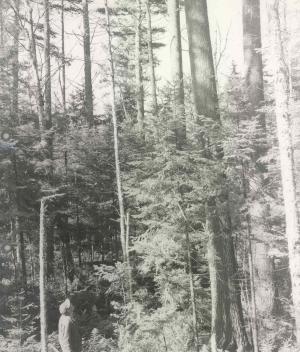| Collection: | Paul Smith Experimental Forest Historical Photo Archive |
| Keywords: | personnel |
| Organisms: | balsam fir |
| Location: | Paul Smith Experimental Forest; Compartment 29 |
| Description: | In October 1956. |
| Date: | 1956 |
| Collection: | Paul Smith Experimental Forest Historical Photo Archive |
| Keywords: |
personnel blowdown |
| Organisms: | balsam fir |
| Location: | Paul Smith Experimental Forest; Compartment 29 |
| Description: | In October 1956. |
| Date: | 1956 |
| Collection: | Paul Smith Experimental Forest Historical Photo Archive |
| Keywords: |
old growth softwood personnel |
| Organisms: |
white pine red spruce balsam fir |
| Location: | Paul Smith Experimental Forest |
| Description: | Overstory of 100-year-old white pine with dense understory of tolerant balsam fir and red spruce. This is typical in this vicinity. There is little opportunity for new white pines. These 100-year-old pines originated after an extremely hot fire burned heavy softwood slash. |
| Date: | 1950 |
| Collection: | Paul Smith Experimental Forest Historical Photo Archive |
| Keywords: |
personnel second growth post harvest |
| Organisms: |
white pine red spruce balsam fir |
| Location: | Paul Smith Experimental Forest |
| Description: | After large white pines were cut about 40 years ago, these understory red spruce and balsam fir - and a few pines - occupied the site. |
| Date: | 1950 |
| Collection: | Paul Smith Experimental Forest Historical Photo Archive |
| Keywords: |
personnel harvest log deck stump |
| Organisms: |
white pine balsam fir spruce |
| Location: | Paul Smith Experimental Forest |
| Description: | After a stand of large pines were cut about 1900, understory balsam fir and spruce developed to pulpwood size. Only a few pines originated after the cutting in 1900, because spruce and fir already occupied the site. |
| Date: | 1950 |
| Collection: | Paul Smith Experimental Forest Historical Photo Archive |
| Keywords: | softwood |
| Organisms: |
balsam fir red spruce |
| Location: | Paul Smith Experimental Forest |
| Description: | Loss of occassional stems from this dense stand of softwoods was enough to encourage balsam fir and red spruce seedlings. Few hardwoods develop under these circumstances. Soil moisture is abundant and probably has a strong influence. |
| Date: | 1950 |
| Collection: | Paul Smith Experimental Forest Historical Photo Archive |
| Keywords: | hardwood |
| Organisms: |
red maple balsam fir |
| Location: | Paul Smith Experimental Forest |
| Description: | On the Farm Woodlot poor-quality red maples were poisoned to release balsam fir. The maple at the left is riddled with heart rot. These red maples occupied this site for 40 years and most of them now prove to be unmerchantable because of extensive heartrot. "Have 40 years been wasted? Can we anticipate this and prevent it? Is it worth it?" |
| Date: | 1950 |
| Collection: | Paul Smith Experimental Forest Historical Photo Archive |
| Keywords: |
personnel post-harvest |
| Organisms: |
red spruce white pine balsam fir |
| Location: | Paul Smith Experimental Forest |
| Description: | Understory red spruce, balsam fir, and a few white pines occupied the site after large overstory pines were cut about 40 years ago. |
| Date: | 1950 |
| Collection: | Paul Smith Experimental Forest Historical Photo Archive |
| Keywords: |
personnel blowdown |
| Organisms: | balsam fir |
| Location: | Paul Smith Experimental Forest |
| Description: | Balsam fir, about 70 years old, was partially uprooted by hurricane Hazel. |
| Date: | 1950 |
| Collection: | Paul Smith Experimental Forest Historical Photo Archive |
| Keywords: |
personnel pre-harvest |
| Organisms: | balsam fir |
| Location: | Paul Smith Experimental Forest |
| Description: | Part of stand at lower elevation, before cutting occurred in 1955. |
| Date: | 1950 |










